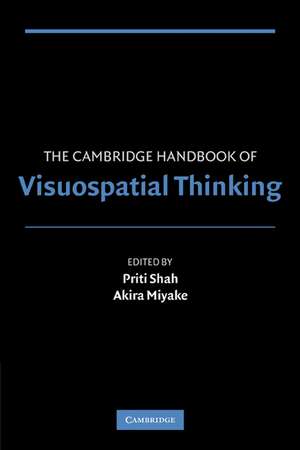The Cambridge Handbook of Visuospatial Thinking: Cambridge Handbooks in Psychology
Editat de Priti Shah, Akira Miyakeen Limba Engleză Paperback – 17 iul 2005
| Toate formatele și edițiile | Preț | Express |
|---|---|---|
| Paperback (1) | 441.81 lei 43-57 zile | |
| Cambridge University Press – 17 iul 2005 | 441.81 lei 43-57 zile | |
| Hardback (1) | 623.16 lei 43-57 zile | |
| Cambridge University Press – 24 iul 2005 | 623.16 lei 43-57 zile |
Din seria Cambridge Handbooks in Psychology
- 23%
 Preț: 1254.71 lei
Preț: 1254.71 lei - 11%
 Preț: 449.49 lei
Preț: 449.49 lei -
 Preț: 502.52 lei
Preț: 502.52 lei -
 Preț: 501.96 lei
Preț: 501.96 lei - 8%
 Preț: 426.60 lei
Preț: 426.60 lei -
 Preț: 486.56 lei
Preț: 486.56 lei - 5%
 Preț: 441.42 lei
Preț: 441.42 lei - 9%
 Preț: 1282.42 lei
Preț: 1282.42 lei -
 Preț: 494.25 lei
Preț: 494.25 lei - 8%
 Preț: 429.69 lei
Preț: 429.69 lei - 5%
 Preț: 397.85 lei
Preț: 397.85 lei - 23%
 Preț: 1246.12 lei
Preț: 1246.12 lei - 5%
 Preț: 439.60 lei
Preț: 439.60 lei - 19%
 Preț: 494.19 lei
Preț: 494.19 lei - 5%
 Preț: 718.47 lei
Preț: 718.47 lei -
 Preț: 511.59 lei
Preț: 511.59 lei - 8%
 Preț: 426.60 lei
Preț: 426.60 lei - 8%
 Preț: 427.05 lei
Preț: 427.05 lei - 8%
 Preț: 425.42 lei
Preț: 425.42 lei -
 Preț: 411.90 lei
Preț: 411.90 lei -
 Preț: 272.34 lei
Preț: 272.34 lei - 8%
 Preț: 425.42 lei
Preț: 425.42 lei - 9%
 Preț: 594.27 lei
Preț: 594.27 lei -
 Preț: 511.21 lei
Preț: 511.21 lei - 23%
 Preț: 1248.79 lei
Preț: 1248.79 lei -
 Preț: 370.88 lei
Preț: 370.88 lei - 8%
 Preț: 424.41 lei
Preț: 424.41 lei -
 Preț: 374.90 lei
Preț: 374.90 lei - 8%
 Preț: 427.49 lei
Preț: 427.49 lei -
 Preț: 511.59 lei
Preț: 511.59 lei - 5%
 Preț: 1538.86 lei
Preț: 1538.86 lei - 23%
 Preț: 2195.06 lei
Preț: 2195.06 lei - 8%
 Preț: 489.88 lei
Preț: 489.88 lei - 8%
 Preț: 428.36 lei
Preț: 428.36 lei -
 Preț: 488.47 lei
Preț: 488.47 lei - 9%
 Preț: 850.10 lei
Preț: 850.10 lei - 8%
 Preț: 430.05 lei
Preț: 430.05 lei -
 Preț: 497.35 lei
Preț: 497.35 lei -
 Preț: 283.03 lei
Preț: 283.03 lei
Preț: 441.81 lei
Nou
Puncte Express: 663
Preț estimativ în valută:
84.54€ • 88.49$ • 70.36£
84.54€ • 88.49$ • 70.36£
Carte tipărită la comandă
Livrare economică 31 martie-14 aprilie
Preluare comenzi: 021 569.72.76
Specificații
ISBN-13: 9780521001731
ISBN-10: 0521001730
Pagini: 580
Ilustrații: 75 b/w illus. 8 tables
Dimensiuni: 153 x 227 x 30 mm
Greutate: 0.83 kg
Ediția:New.
Editura: Cambridge University Press
Colecția Cambridge University Press
Seria Cambridge Handbooks in Psychology
Locul publicării:New York, United States
ISBN-10: 0521001730
Pagini: 580
Ilustrații: 75 b/w illus. 8 tables
Dimensiuni: 153 x 227 x 30 mm
Greutate: 0.83 kg
Ediția:New.
Editura: Cambridge University Press
Colecția Cambridge University Press
Seria Cambridge Handbooks in Psychology
Locul publicării:New York, United States
Cuprins
1. Functional significance of visuospatial representations Barbara Tversky; 2. Visuospatial images Daniel Reisberg and Friderike Heuer; 3. Disorders of visuospatial working memory Robert Logie and Sergio Della Sala; 4. Individual differences in spatial abilities Mary Hegarty and David Waller; 5. Sex differences in visuospatial abilities: more than meets the eye Diane F. Halpern and Marcia L. Collear; 6. Development of spatial competence Nora S. Newcombe and Amy E. Learmonth; 7. Navigation Daniel R. Montello; 8. Mapping the understanding of understanding maps Holly A. Taylor; 9. Spatial situation models Mike Rinck; 10. Design applications of visual spatial thinking: the importance of frame of reference Christopher D. Wickens, Michele Vincow and Michele Yeh; 11. The presentation and comprehension of graphically-presented data Priti Shah, Eric G. Freedman and Ioanna Vekiri; 12. Multimedia learning: guiding visuospatial thinking with instructional animation Richard E. Mayer.
Recenzii
' … a wonderful book for anyone who subscribers to the cognitive psychology paradigm.' American Journal of Psychology
Descriere
This book, first published in 2005, presents an in-depth coverage of visuospatial thinking, encompassing a wide range of thinking processes concerning space.














